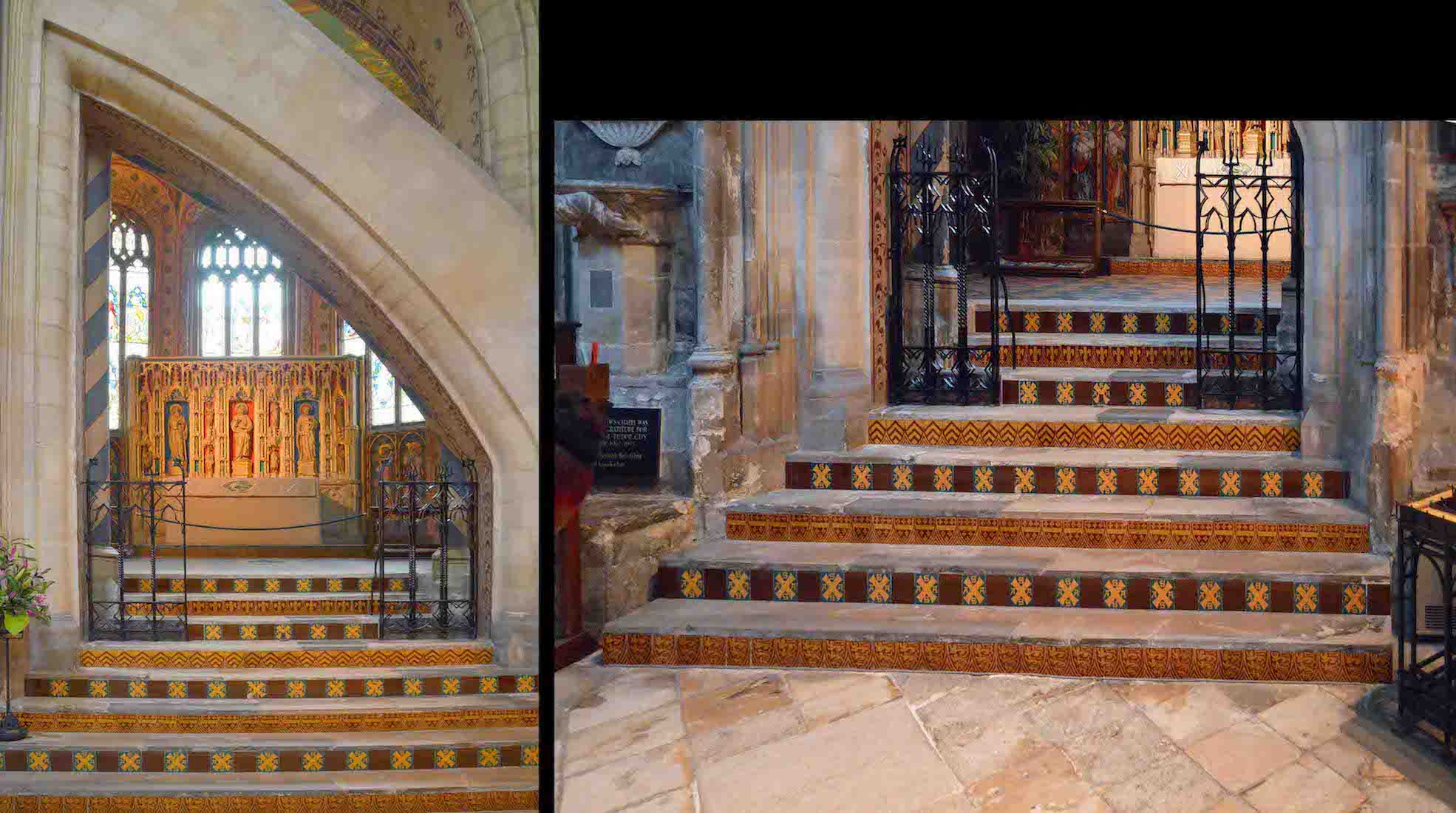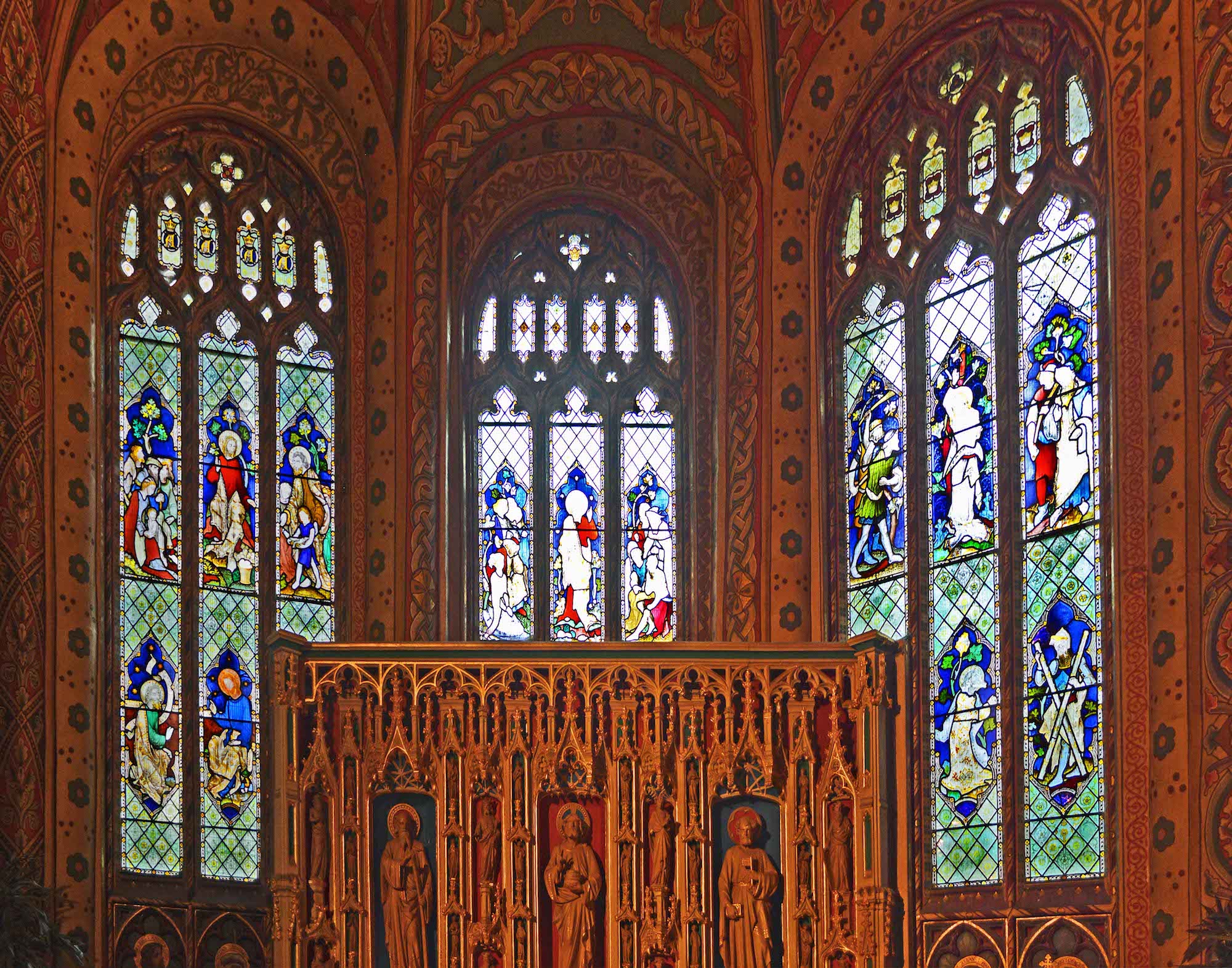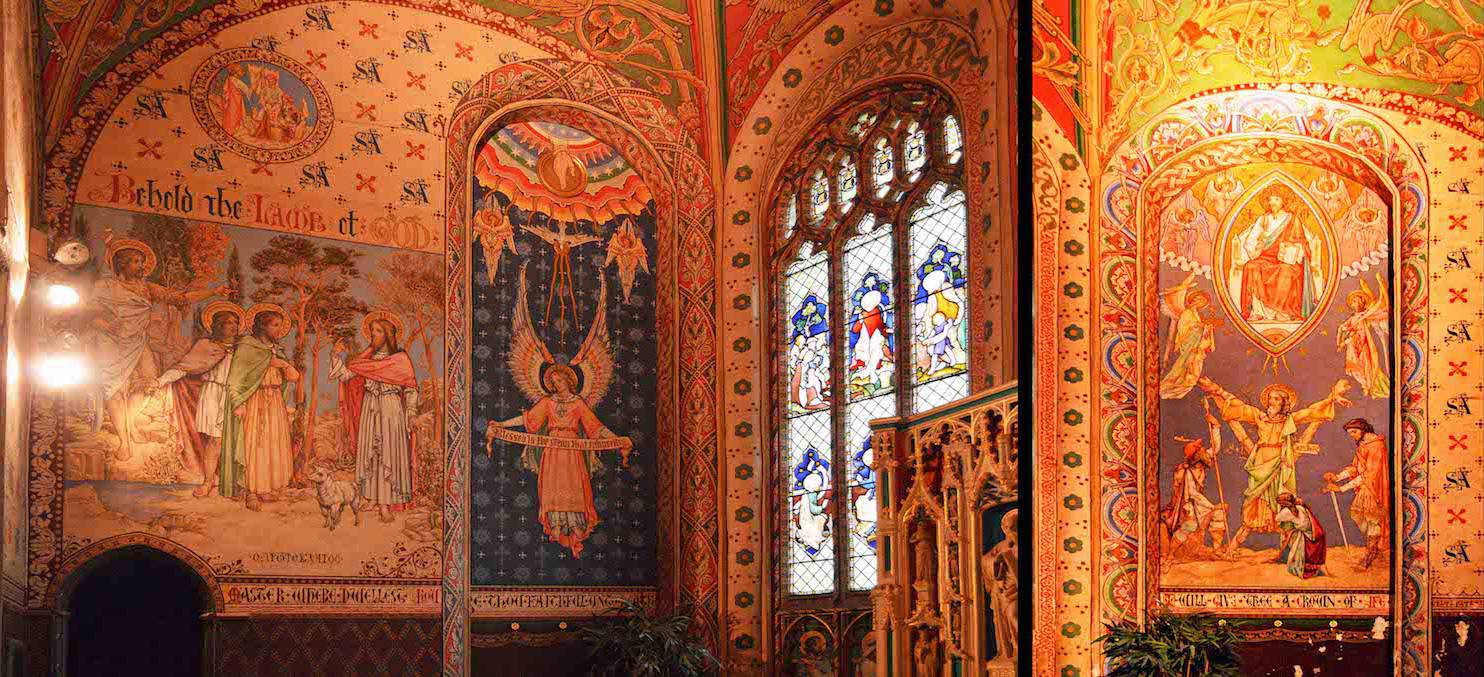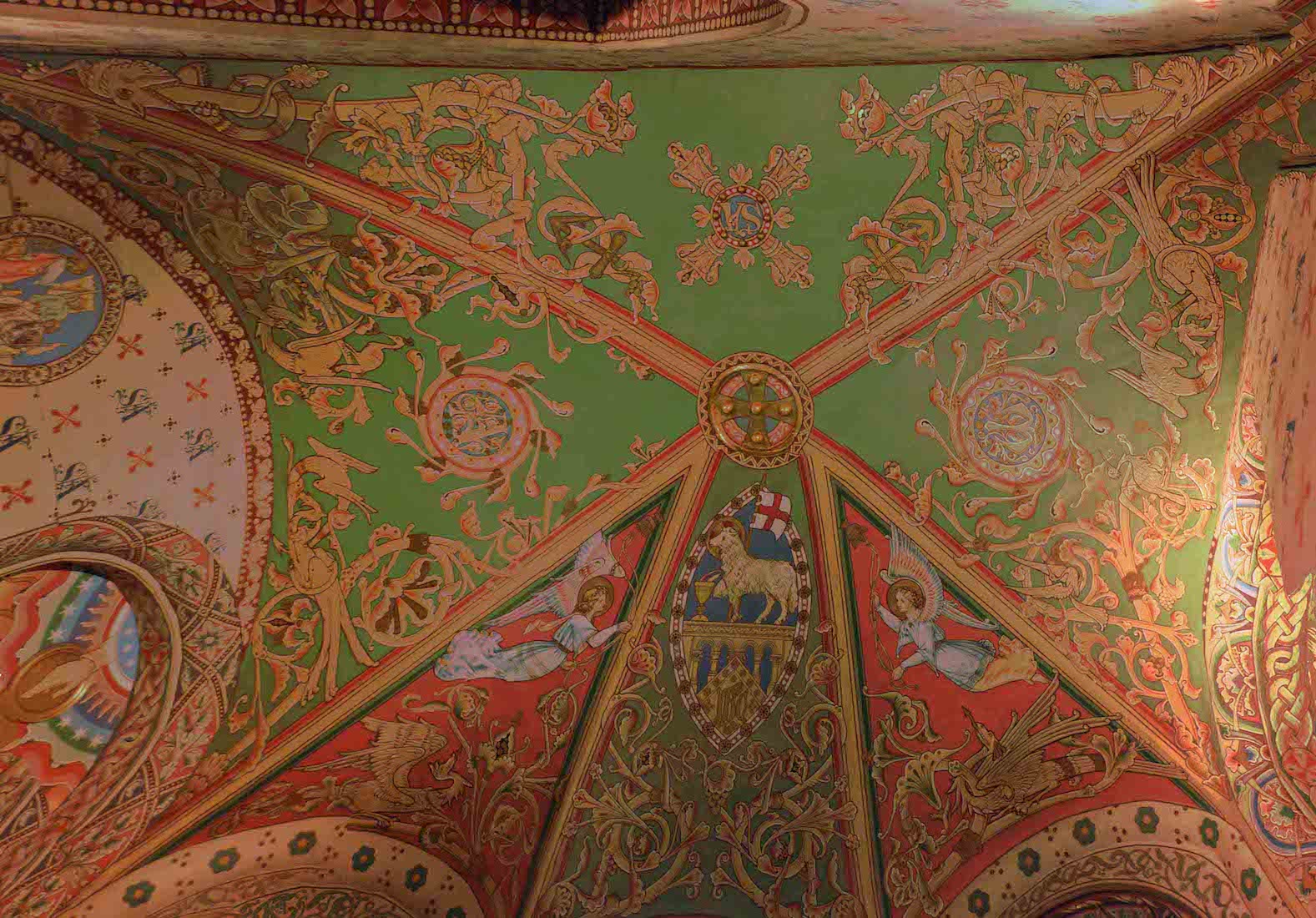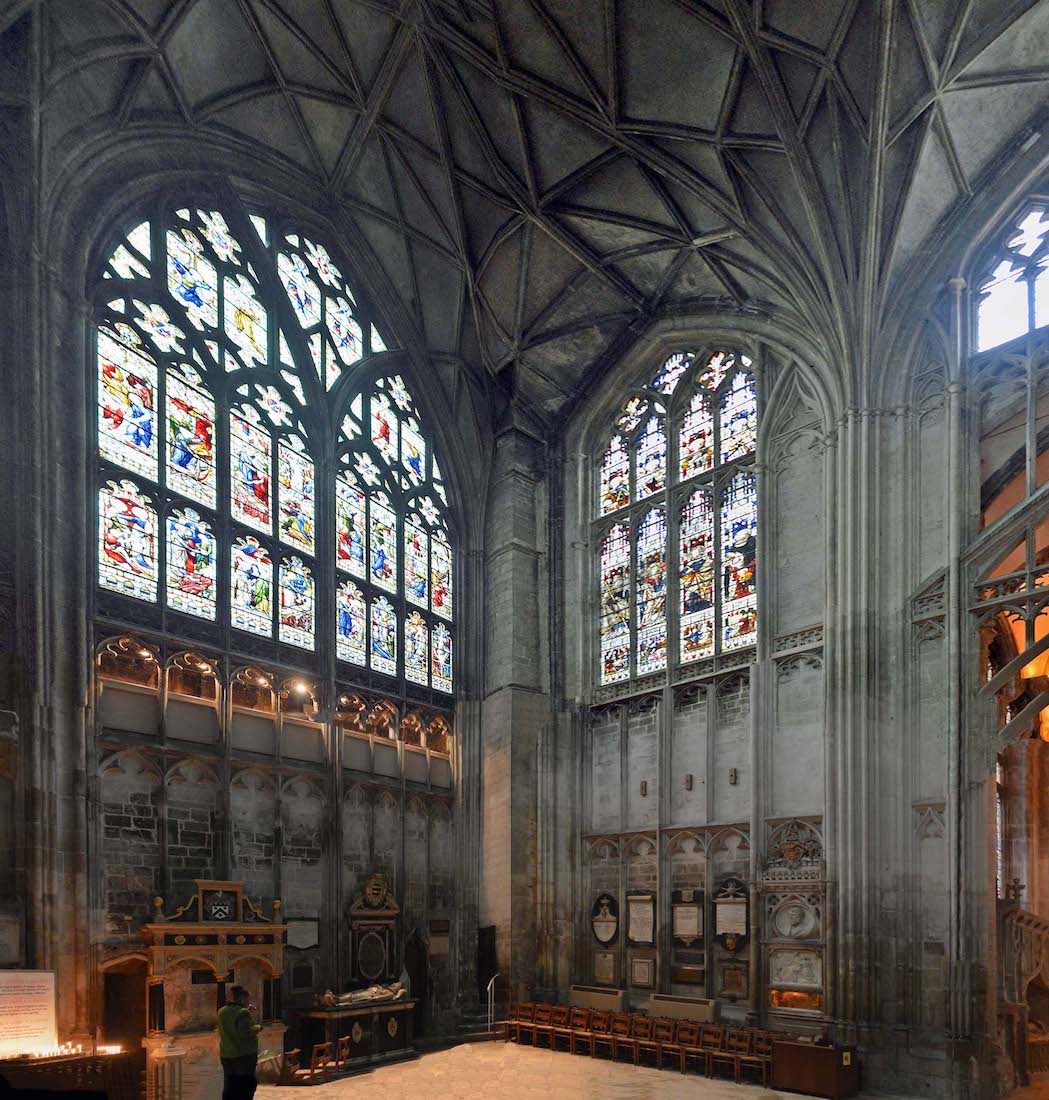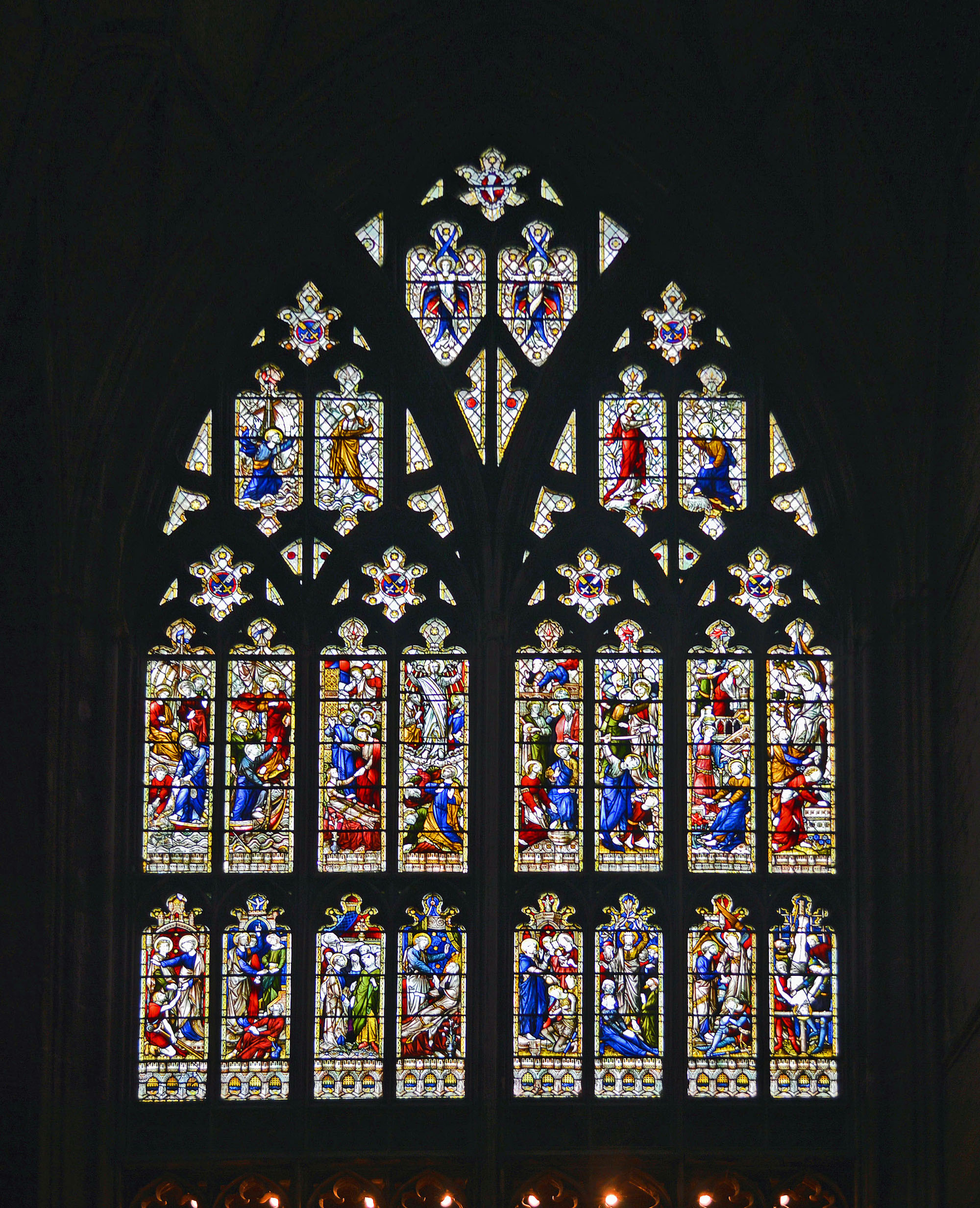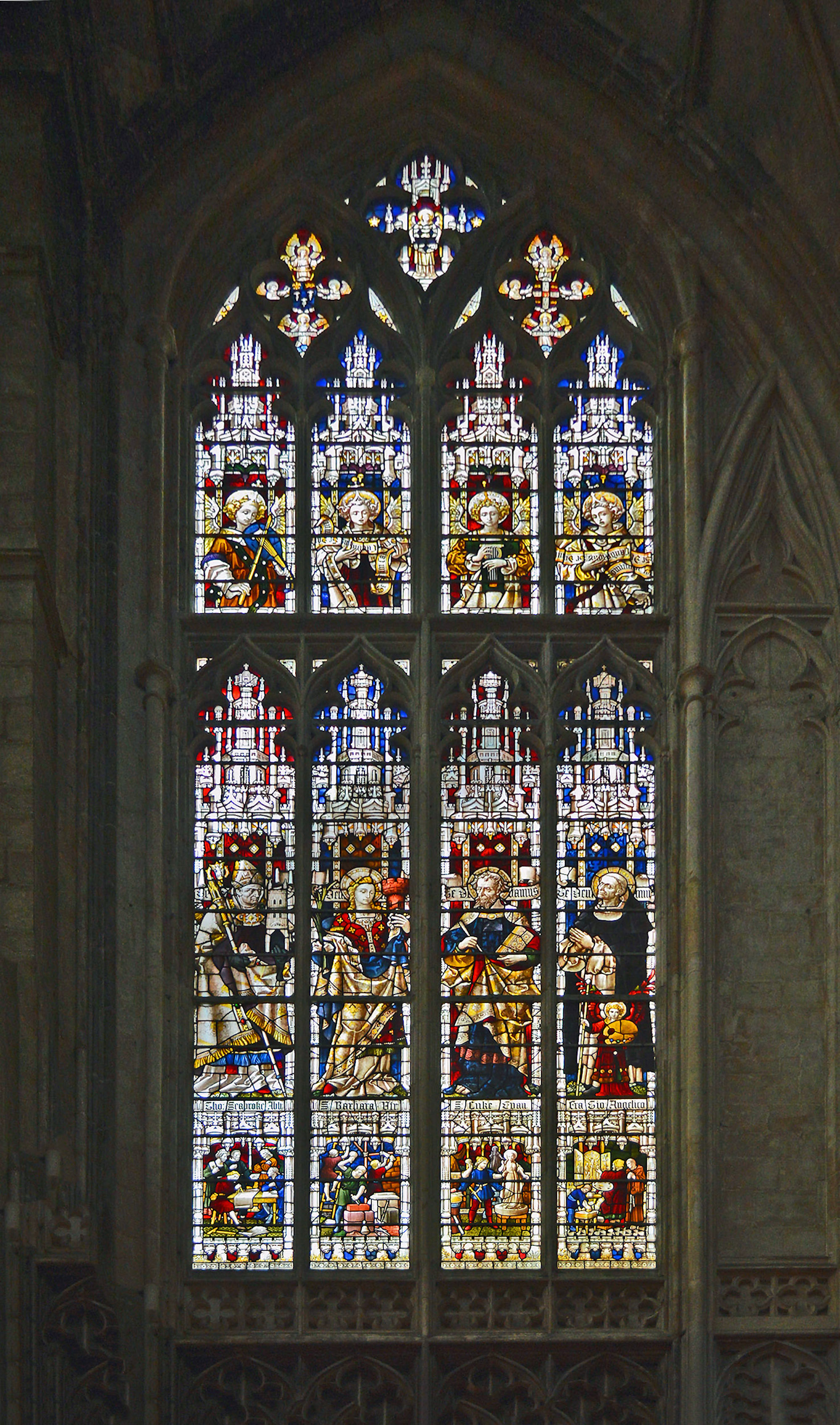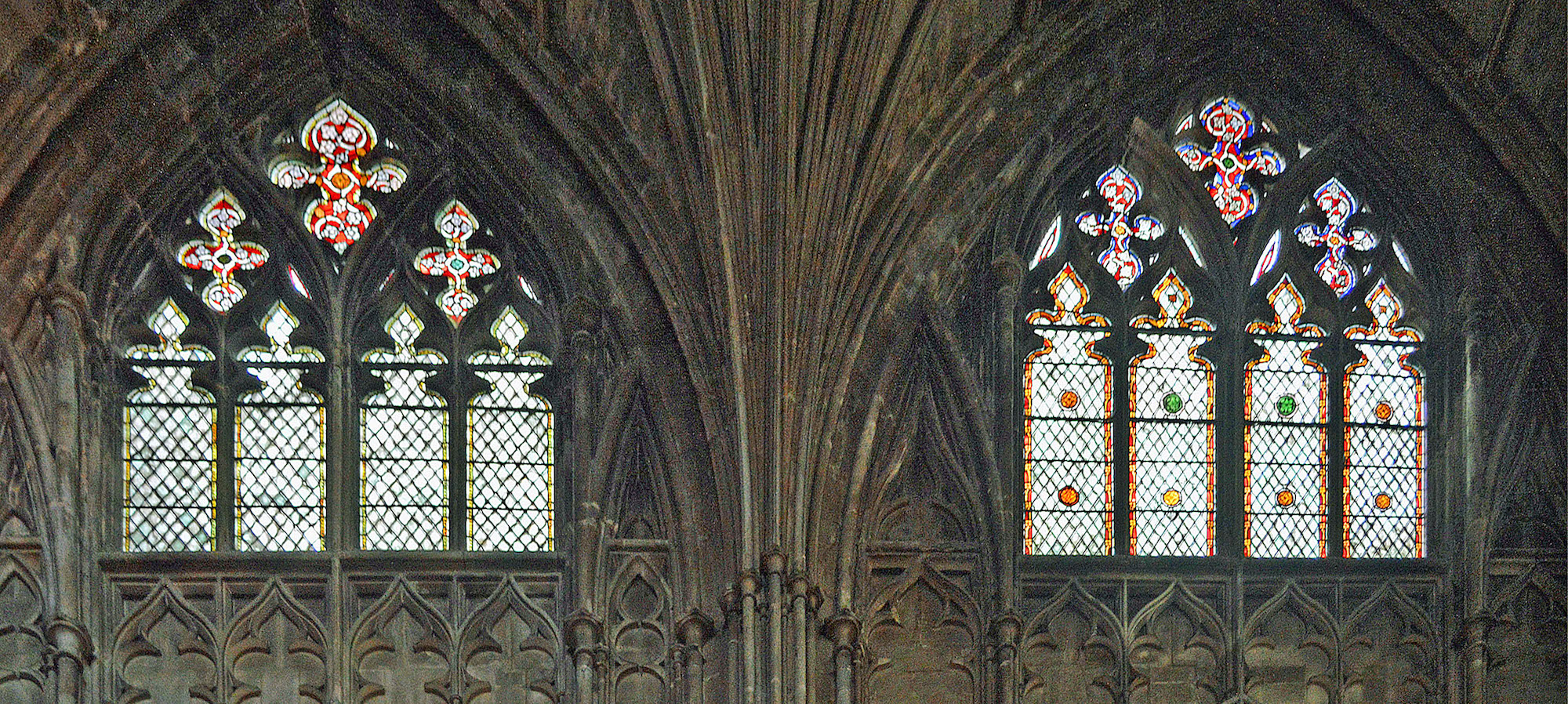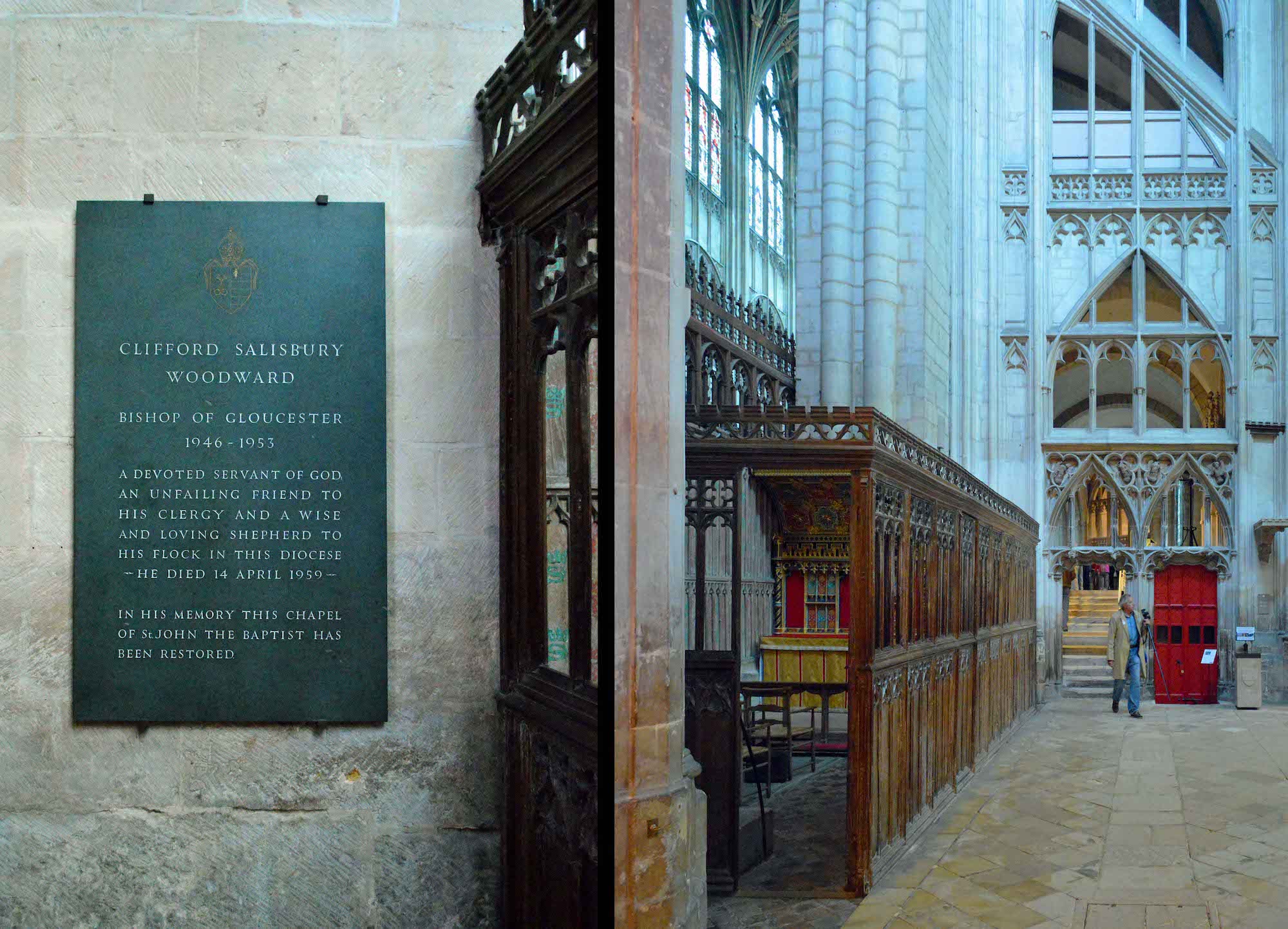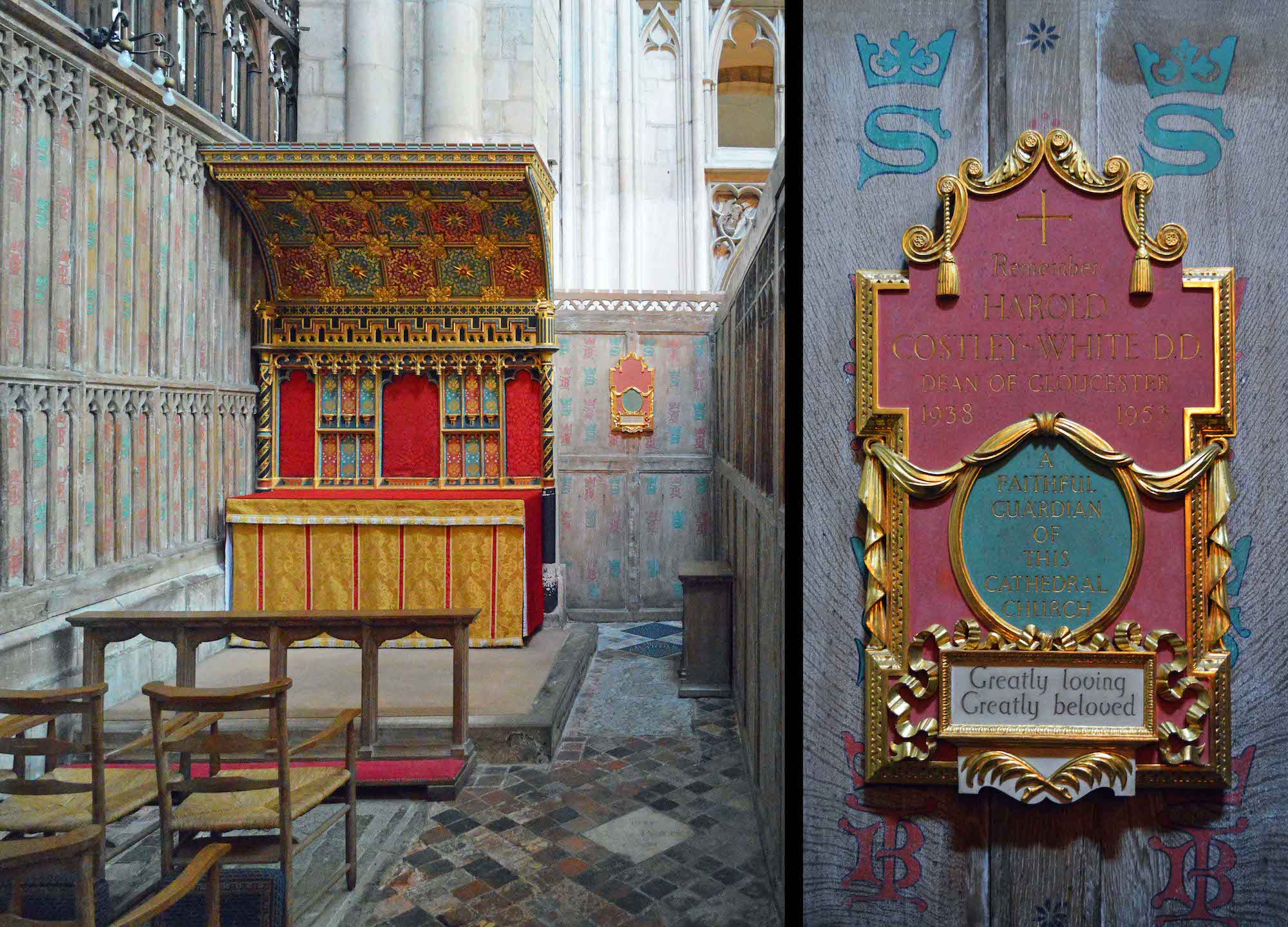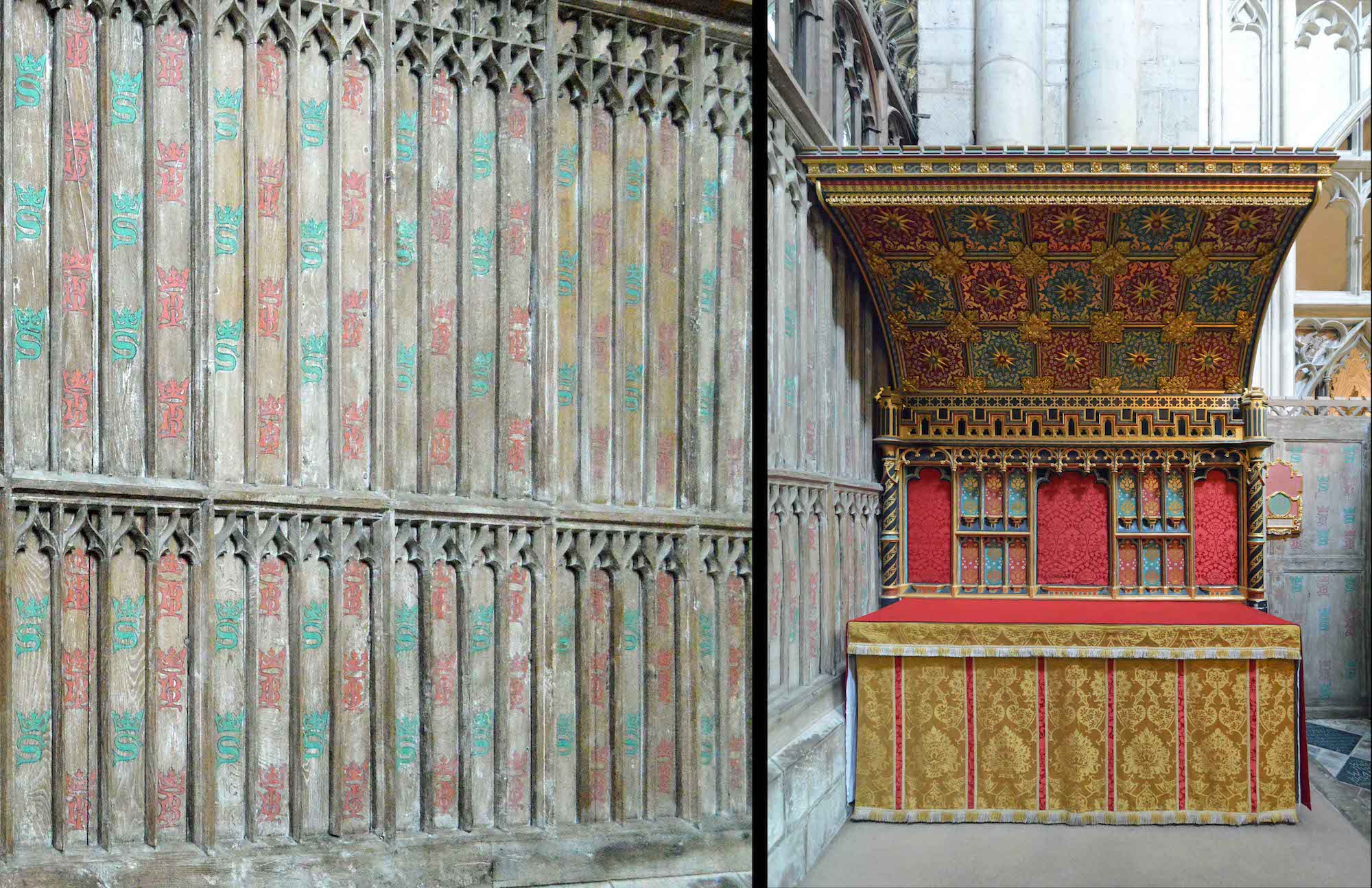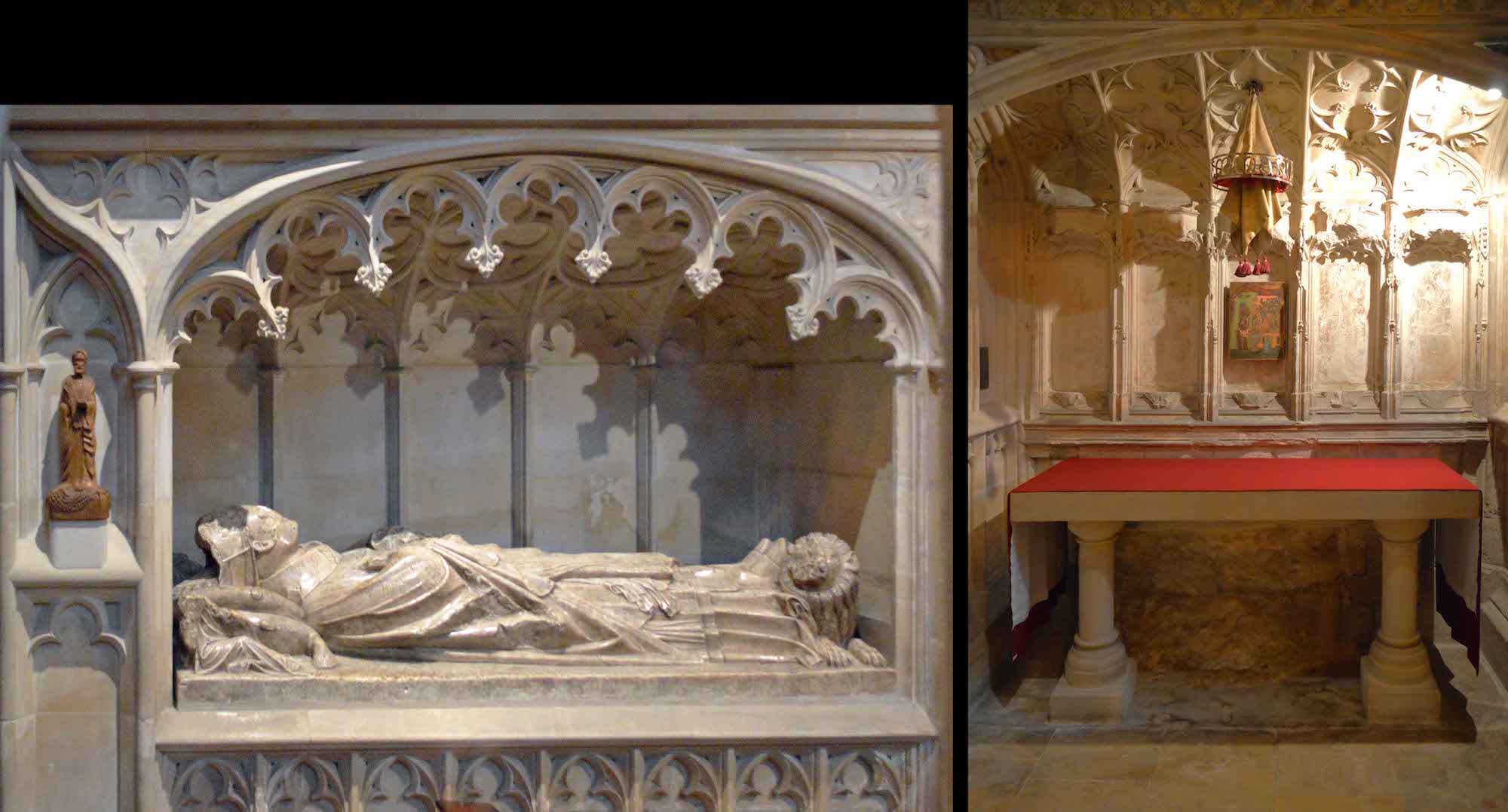101. HOLY FAMILY AND COPE CHEST

We leave St Philip’s Chapel (or has it become St Thomas’s Chapel?) and walk along the South ambulatory towards the nave. On the outer wall to our left there are three stained glass windows, and below, a statue of the Holy Family, and a large cope chest. ‘The Holy Family’ is by Josefina de Vasconcellos (1904 – 2005). It is a fibre-glass cast of the bronze statue in St Martin-in-the-Fields Church in London. PLAN
102. SOUTH AMBULATORY WINDOWS

Each of the three South ambulatory windows depicts four figures with a life-scene below each. From left these appear to be: • Isaiah, St John the Baptist, Jesus Lamb of God, St John the Evangelist; • Adam, Noah, Abraham, Moses; • St Augustine, St Elizabeth, St Christopher, St Elizabeth of Hungary.
103. FOLIOT EFFIGY
Opposite the windows, there are two tombs with effigies. The Eastern-most one is the effigy of Henry Foliot, who was Abbot of Gloucester from 1228 to 1243. The plaque above is a little misleading, referring to Charles John Ellicot who died in 1906. He was Bishop of Gloucester from 1863 to 1905.
104. TOMB OF ROBERT, DUKE OF NORMANDY
Then further along we find Robert (b 1054), who was the oldest son of William the Conqueror. Though he had rebelled against his father in 1077 and in 1082, he became Duke of Normandy when William died in 1087. He participated in the First Crusade 1097-99. After the sudden death of his brother, William Rufus, in a mysterious hunting accident in 1100, Robert contended with his youngest brother, Henry I for the English throne. He was defeated by Henry at the Battle of Tinchbrai on Sept. 28, 1106, and remained a captive until his death in 1134 at Cardiff Castle, Wales. The date of the effigy is unknown, but probably before 1300. The figure has legs crossed, the right hand pulling the sword from the scabbard. During the English Civil War, the effigy was broken into pieces and sold to Sir Humphrey Tracey of Stanway. It was returned to the Cathedral after the Restoration.
105. TO ST ANDREW’S CHAPEL
The St Andrew’s Chapel corresponds to the St Paul’s Chapel on the Northern side. It can be accessed from the South ambulatory, or as here from the South transept. The risers of the steps are decorated with shields and diagonal St Andrew’s crosses.
106. CHAPEL ALTAR
The reredos contains a central figure of the Saviour between St Andrew and St Peter, with eight figures of smaller size: Job, Solomon, Moses, David, Isaiah, Jeremiah, Ezekiel and Daniel. The remaining figures represent a choir of angels.
107. CHAPEL WINDOWS
The windows contain glass by Hardmar dealing with events in the life of St Andrew.
108. CHAPEL WALL PANELS
The paintings on the wall were executed in 1866-67 in spirit fresco (a type of preparation for varnish painting) by Thomas Gambier Parry for Thomas Marling Esq, in memory of his wife who died in 1863.
109. CHAPEL CEILING
The vault of St Andrew's Chapel was decorated by Thomas Gambier Parry in 1868. Parry also painted the lantern of Ely Cathedral.
110. SOUTH TRANSEPT
Leaving St Andrew’s Chapel we emerge into the South transept. Two very large windows meet at the Southwest corner. The lighted walkway below the South window leads from the Tribune Gallery, and exits in the corner. At ground level we can see a tomb and effigy, and also a model of the Cathedral at right.
111. TOMB AND EFFIGY, MODEL
The tomb monument is of Abraham Blackleech and his wife Gertrude, and dates from 1639. His epitaph talks of a man generally beloved in his life and endeared to posterity, remembered for his bounty to St Paul’s, this church, to the high ways about and the poor in the city. The wooden model is interesting in that it not only shows the cathedral in three dimensions, but also shows the footings.
112. SOUTH TRANSEPT WINDOW
This window is The Life of St Peter by Hardman, 1871. The upper part of the window in the four main lights of the tracery shows Christ walking on water and Saint Peter reaching out, Christ giving the keys to Saint Peter and Peter kneeling to receive his charge. Below this tier is:- The miraculous catch of fish. The call of Saint Peter and Saint Andrew. The raising of Jairus’ daughter. The Transfiguration. The washing of the disciples feet. The betrayal. The denial. The scene at the tomb. The eight bottom lights depict:- The Cure of the lame beggar. The death of Ananias. Saint Peter surrounded by weeping women. The raising of Tabitha. The baptism of Cornelius. Saint Peter preaching. Saint Peter delivered from prison. Saint Peter being crucified upside down.
113. SOUTH TRANSEPT WEST WINDOW
This West window is filled with glass in memory of Thomas Gambier Parry.
114. SOUTH TRANSEPT CLERESTORY WINDOWS
These high clerestory windows are on the East wall of the transept. It is claimed that this is some of the best glass now to be found in the Cathedral, dating to about 1330. At the top there is a white scroll-work of vine leaves on a ruby coloured background, with plain lattice work below and simple borders.
115. CHAPEL OF ST JOHN THE BAPTIST
On the North side of the South transept is a chapel behind a wooden screen, dating from ca 1510. The chapel is said to have been dedicated by John Browne who was Abbott from 1510–1514 to his patron saint, St John the Baptist, the initials being the same. The tablet at left remembers Bishop Clifford Woodward.
116. CHAPEL LOOKING EAST
There is an altar and memorial at the end of this chapel. The memorial is to Harold Costily White who was Dean of Gloucester 1938 – 1953. His epitaph is: Greatly loving, Greatly loved.
117. CHAPEL WALL AND ALTAR
The inside panelling is covered with monograms of S and I/B, all surmounted by crowns. Presumably these stand for Saint John (the) Baptist. The altar, reredos and canopy appear as a single unit, with the reredos having a flowery motif, and the canopy bearing a grid pattern of images of suns and stars.
118. SOUTH AISLE LOOKING EAST
We have nearly completed our investigation of this part of the cathedral, but there is one more small section. We follow the South nave aisle Westward until we just reach the nave, and then turn to face back. There is a chapel and statue on our left, and a large niche in the wall on our right. This niche contains the effigies of a man and his wife – apparently unidentified.
119. SEABROKE CHANTRY CHAPEL
On our left is the Seabroke Chapel honoring Thomas Seabroke, who was Abbot of Gloucester Abbey from 1450 to his death in 1457. Just beyond the Chapel is a life size statue of Kyneburga who was the first Abbess of Gloucester. Kyneburga was the sister of Osric, Prince of Mercia, who founded the Saxon Abbey of St Peter in Gloucester ca 679. It was a double monastery of men and women, and Kyneburga was abbess intil her death in 710.
120. EFFIGY AND ALTAR
The Chapel contains an alabastar effigy of Seabroke on a tomb chest. The Blessed Sacrament hangs over the chapel’s altar.




